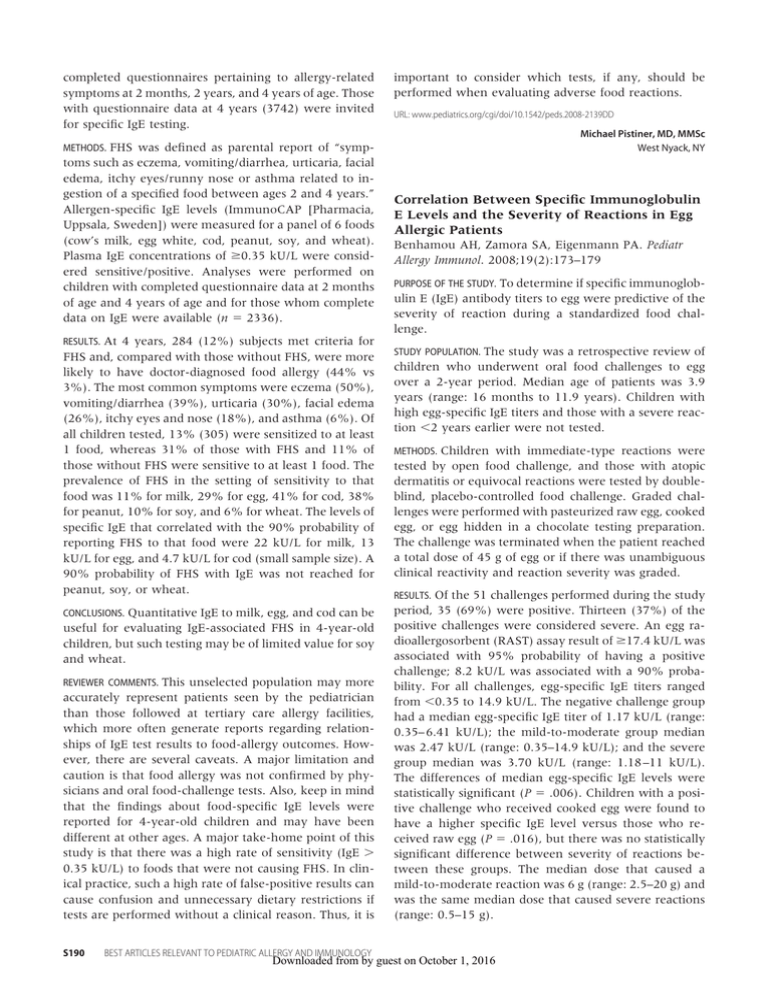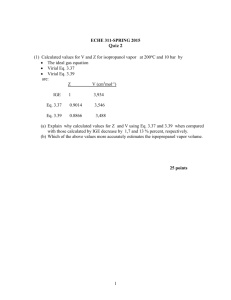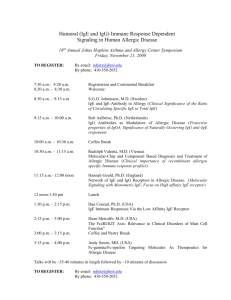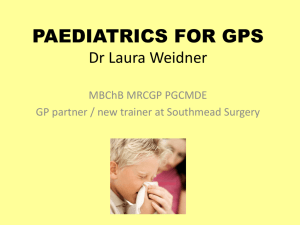
completed questionnaires pertaining to allergy-related
symptoms at 2 months, 2 years, and 4 years of age. Those
with questionnaire data at 4 years (3742) were invited
for specific IgE testing.
important to consider which tests, if any, should be
performed when evaluating adverse food reactions.
URL: www.pediatrics.org/cgi/doi/10.1542/peds.2008-2139DD
Michael Pistiner, MD, MMSc
West Nyack, NY
METHODS. FHS was defined as parental report of “symp-
toms such as eczema, vomiting/diarrhea, urticaria, facial
edema, itchy eyes/runny nose or asthma related to ingestion of a specified food between ages 2 and 4 years.”
Allergen-specific IgE levels (ImmunoCAP [Pharmacia,
Uppsala, Sweden]) were measured for a panel of 6 foods
(cow’s milk, egg white, cod, peanut, soy, and wheat).
Plasma IgE concentrations of ⱖ0.35 kU/L were considered sensitive/positive. Analyses were performed on
children with completed questionnaire data at 2 months
of age and 4 years of age and for those whom complete
data on IgE were available (n ⫽ 2336).
RESULTS. At 4 years, 284 (12%) subjects met criteria for
FHS and, compared with those without FHS, were more
likely to have doctor-diagnosed food allergy (44% vs
3%). The most common symptoms were eczema (50%),
vomiting/diarrhea (39%), urticaria (30%), facial edema
(26%), itchy eyes and nose (18%), and asthma (6%). Of
all children tested, 13% (305) were sensitized to at least
1 food, whereas 31% of those with FHS and 11% of
those without FHS were sensitive to at least 1 food. The
prevalence of FHS in the setting of sensitivity to that
food was 11% for milk, 29% for egg, 41% for cod, 38%
for peanut, 10% for soy, and 6% for wheat. The levels of
specific IgE that correlated with the 90% probability of
reporting FHS to that food were 22 kU/L for milk, 13
kU/L for egg, and 4.7 kU/L for cod (small sample size). A
90% probability of FHS with IgE was not reached for
peanut, soy, or wheat.
CONCLUSIONS. Quantitative IgE to milk, egg, and cod can be
useful for evaluating IgE-associated FHS in 4-year-old
children, but such testing may be of limited value for soy
and wheat.
REVIEWER COMMENTS. This unselected population may more
accurately represent patients seen by the pediatrician
than those followed at tertiary care allergy facilities,
which more often generate reports regarding relationships of IgE test results to food-allergy outcomes. However, there are several caveats. A major limitation and
caution is that food allergy was not confirmed by physicians and oral food-challenge tests. Also, keep in mind
that the findings about food-specific IgE levels were
reported for 4-year-old children and may have been
different at other ages. A major take-home point of this
study is that there was a high rate of sensitivity (IgE ⬎
0.35 kU/L) to foods that were not causing FHS. In clinical practice, such a high rate of false-positive results can
cause confusion and unnecessary dietary restrictions if
tests are performed without a clinical reason. Thus, it is
S190
BEST ARTICLES RELEVANT TO PEDIATRIC ALLERGY AND IMMUNOLOGY
Correlation Between Specific Immunoglobulin
E Levels and the Severity of Reactions in Egg
Allergic Patients
Benhamou AH, Zamora SA, Eigenmann PA. Pediatr
Allergy Immunol. 2008;19(2):173–179
PURPOSE OF THE STUDY. To determine if specific immunoglob-
ulin E (IgE) antibody titers to egg were predictive of the
severity of reaction during a standardized food challenge.
STUDY POPULATION. The study was a retrospective review of
children who underwent oral food challenges to egg
over a 2-year period. Median age of patients was 3.9
years (range: 16 months to 11.9 years). Children with
high egg-specific IgE titers and those with a severe reaction ⬍2 years earlier were not tested.
METHODS. Children with immediate-type reactions were
tested by open food challenge, and those with atopic
dermatitis or equivocal reactions were tested by doubleblind, placebo-controlled food challenge. Graded challenges were performed with pasteurized raw egg, cooked
egg, or egg hidden in a chocolate testing preparation.
The challenge was terminated when the patient reached
a total dose of 45 g of egg or if there was unambiguous
clinical reactivity and reaction severity was graded.
RESULTS. Of the 51 challenges performed during the study
period, 35 (69%) were positive. Thirteen (37%) of the
positive challenges were considered severe. An egg radioallergosorbent (RAST) assay result of ⱖ17.4 kU/L was
associated with 95% probability of having a positive
challenge; 8.2 kU/L was associated with a 90% probability. For all challenges, egg-specific IgE titers ranged
from ⬍0.35 to 14.9 kU/L. The negative challenge group
had a median egg-specific IgE titer of 1.17 kU/L (range:
0.35– 6.41 kU/L); the mild-to-moderate group median
was 2.47 kU/L (range: 0.35–14.9 kU/L); and the severe
group median was 3.70 kU/L (range: 1.18 –11 kU/L).
The differences of median egg-specific IgE levels were
statistically significant (P ⫽ .006). Children with a positive challenge who received cooked egg were found to
have a higher specific IgE level versus those who received raw egg (P ⫽ .016), but there was no statistically
significant difference between severity of reactions between these groups. The median dose that caused a
mild-to-moderate reaction was 6 g (range: 2.5–20 g) and
was the same median dose that caused severe reactions
(range: 0.5–15 g).
Downloaded from by guest on October 1, 2016
CONCLUSIONS. There is a correlation between median egg-
specific IgE levels and the severity of reaction during oral
food challenge to egg. These levels may be helpful in
predicting a potential reaction to egg.
REVIEWER COMMENTS. It is often assumed that reaction sever-
ity correlates with the food-specific IgE level, but most
studies have refuted this notion. Here, a relationship was
determined. However, it is difficult to assess the clinical
utility of these results, because there was considerable
overlap of the ranges of egg-specific IgE levels between
groups. These findings may be more relevant to the
controlled setting of a diagnostic food challenge rather
than to the community setting in which a large or uncontrolled dose of egg might be ingested. In a real-life
setting, a severe reaction may occur even with a low
egg-specific IgE level, particularly if one considers patient-dependent factors such as concurrent diagnosis of
asthma or personal history of a previous severe reaction.
URL: www.pediatrics.org/cgi/doi/10.1542/peds.2008-2139EE
Robbie D. Pesek, MD
Tamara T. Perry, MD
Little Rock, AR
Correlation of Serum Allergy (IgE) Tests
Performed by Different Assay Systems
Wang J, Godbold J, Sampson H. J Allergy Clin Immunol.
2008;121(5):1219 –1224
PURPOSE OF THE STUDY. To compare the allergen-specific im-
munoglobulin E (IgE) testing performed on 3 different
assays (Turbo-MP [Aglient Technologies Co, Santa Clara,
CA], Immulite 2000 [Siemens Medical Solutions Diagnostics, Tarrytown, NY], and ImmunoCAP [Pharmacia,
Uppsala, Sweden]) to determine if IgE levels derived
from different assays are equivalent.
STUDY POPULATION. The study was a prospective analysis of
serum from 50 atopic patients (median age: 7.25 years)
using the 3 different allergen-specific assays (ImmunoCAP, Turbo-MP, and Immulite 2000).
METHODS. Patients being seen at the Mount Sinai pediatric
allergy and immunology practice who were already having blood drawn for routine management were eligible,
and the additional serum was aliquoted into 3 samples
and sent to 3 different commercial laboratories, each of
which used a different assay system. Of the 50 patients
enrolled, 42 were diagnosed with food hypersensitivities, 5 avoided specific foods because of a history of
positive skin-prick tests or serum-specific IgE, and 3 had
no history of food hypersensitivity. Samples were evaluated for specific IgE to egg white, milk, peanut, cat,
birch pollen, and dust mite (Dermatophagoides farinae).
The results were analyzed by using the ImmunoCAP as
the reference system, because published data regarding
decision points for the major food allergens used this
assay system. Values that fell outside of the 20% limits of
agreement were determined for each allergen.
RESULTS. Significant differences were found in the measurement of allergen-specific IgE levels in identical serum samples when using these 3 assays. Immulite 2000
values were consistently higher than the reference standard for all allergens measured; however, levels for D
farinae were not statistically significant. Turbo-MP
showed variability without a trend toward overestimation or underestimation for milk and peanut, overestimated egg-specific IgE levels, and underestimated specific IgE levels for birch pollen. Although all 3 have a
similar distribution of results consistent with the population studied, minor differences in the sources of allergens used may have contributed to the different IgE
levels observed.
CONCLUSIONS. Clinicians cannot substitute a commercial al-
lergen-specific IgE assay for another when making clinical decisions about whether to proceed to an oral food
challenge or in monitoring IgE levels of an individual
patient over time. The published data that are widely
used are based on the ImmunoCAP assay, and the IgE
levels obtained by 2 other assays (Turbo-MP and Immulite) are not equivalent.
REVIEWER COMMENTS. Most published data concerning relationships of food allergy to food-specific IgE test results
were determined by using the ImmunoCAP assay. Although the IgE measurements between the different
assays may correlate well on a statistical basis, the study
considered the differences in absolute values, particularly around decision points widely used by clinicians.
The article shows that applying decision points determined by 1 assay to test results obtained from a different
assay could lead to erroneous advice about management. The authors indicated that additional studies
should be performed to examine reproducibility of the
results and determine assay-specific decision points for
these different testing assays. This study highlights the
fact that knowing what assay is used, in addition to
obtaining a careful clinical history, is an important part
of the evaluation of a child with possible food allergies.
URL: www.pediatrics.org/cgi/doi/10.1542/peds.2008-2139FF
Jennifer Mbuthia, MD
Cecilia P. Mikita, MD, MPH
Washington, DC
Safety of Open Food Challenges in the Office
Setting
Mankad VS, Williams LW, Lee LA, LaBelle GS,
Anstrom KJ, Burks AW. Ann Allergy Asthma Immunol.
2008;100(5):469 – 474
PURPOSE OF THE STUDY. To examine the safety of open food
challenges (OFCs) administered in an office setting.
PEDIATRICS Volume 122, Supplement 4, November 2008
Downloaded from by guest on October 1, 2016
S191
Correlation Between Specific Immunoglobulin E Levels and the Severity of
Reactions in Egg Allergic Patients
Robbie D. Pesek and Tamara T. Perry
Pediatrics 2008;122;S190
DOI: 10.1542/peds.2008-2139EE
Updated Information &
Services
including high resolution figures, can be found at:
/content/122/Supplement_4/S190
Subspecialty Collections
This article, along with others on similar topics, appears in
the following collection(s):
Allergy/Immunology
/cgi/collection/allergy:immunology_sub
Permissions & Licensing
Information about reproducing this article in parts (figures,
tables) or in its entirety can be found online at:
/site/misc/Permissions.xhtml
Reprints
Information about ordering reprints can be found online:
/site/misc/reprints.xhtml
PEDIATRICS is the official journal of the American Academy of Pediatrics. A monthly
publication, it has been published continuously since 1948. PEDIATRICS is owned, published,
and trademarked by the American Academy of Pediatrics, 141 Northwest Point Boulevard, Elk
Grove Village, Illinois, 60007. Copyright © 2008 by the American Academy of Pediatrics. All
rights reserved. Print ISSN: 0031-4005. Online ISSN: 1098-4275.
Downloaded from by guest on October 1, 2016
Correlation Between Specific Immunoglobulin E Levels and the Severity of
Reactions in Egg Allergic Patients
Robbie D. Pesek and Tamara T. Perry
Pediatrics 2008;122;S190
DOI: 10.1542/peds.2008-2139EE
The online version of this article, along with updated information and services, is
located on the World Wide Web at:
/content/122/Supplement_4/S190
PEDIATRICS is the official journal of the American Academy of Pediatrics. A monthly
publication, it has been published continuously since 1948. PEDIATRICS is owned,
published, and trademarked by the American Academy of Pediatrics, 141 Northwest Point
Boulevard, Elk Grove Village, Illinois, 60007. Copyright © 2008 by the American Academy
of Pediatrics. All rights reserved. Print ISSN: 0031-4005. Online ISSN: 1098-4275.
Downloaded from by guest on October 1, 2016



